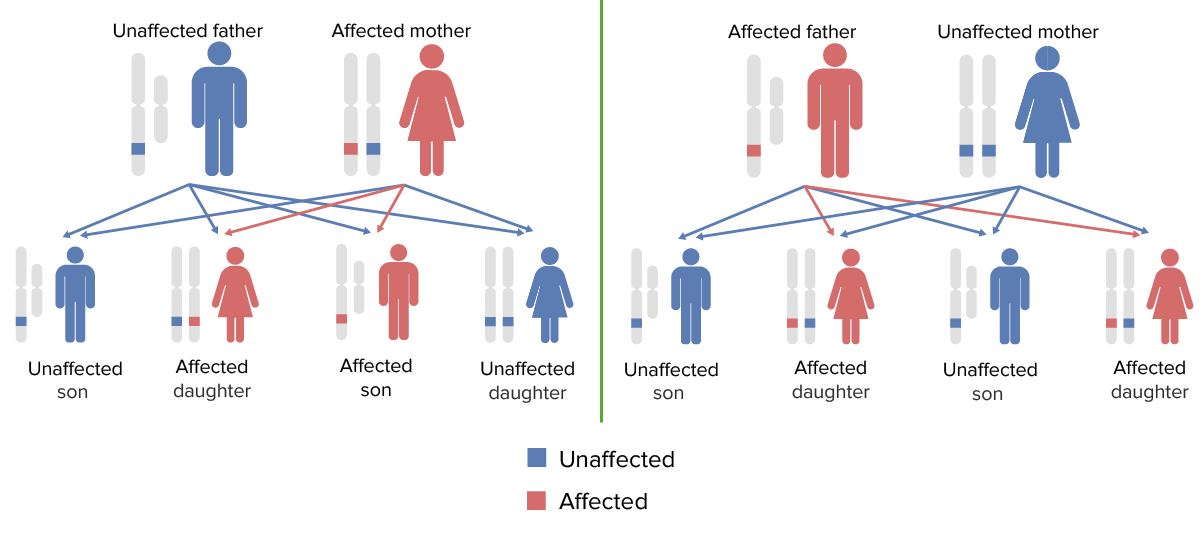La herencia ligada al sexo es una forma de herencia mendeliana. El término describe rasgos que se heredan a través del cromosoma X o Y. Para la transmisión recesiva ligada al cromosoma X, el alelo es recesivo y se transporta en el cromosoma X. Los hombres tienen más probabilidades de expresar trastornos recesivos ligados al cromosoma X porque poseen solo 1 cromosoma X. Para la transmisión dominante ligada al cromosoma X, el alelo es dominante y se transporta en el cromosoma X. Debido a esto, solo se requiere 1 copia del alelo de la enfermedad para la expresión fenotípica. Los trastornos dominantes ligados al cromosoma X son menos comunes que los trastornos recesivos ligados al cromosoma X.
Última actualización: Jul 1, 2022
La herencia ligada al sexo ocurre cuando los rasgos genéticos se heredan en el cromosoma X o Y. Hay 2 principales modos de herencia ligados al sexo: recesivo ligado al cromosoma X y dominante ligado al cromosoma X.
Herencia recesiva ligada al X:
Herencia dominante ligada al X:
Los hijos de un padre no afectado y una madre heterocigota (portadora) tienen los siguientes riesgos:
| Padre no afectado | |||
| x | y | ||
| Madre heterocigota (portadora) | x | xx (mujer no afectada) | xy (hombre no afectado) |
| x | xx (mujer portadora) | xy (hombre afectado) | |
Los hijos de un padre afectado y una madre heterocigota (portadora) tienen los siguientes riesgos:
| Padre hemicigóticamente afectado | |||
| x | y | ||
| Madre heterocigota (portadora) | x | xx (mujer portadora) | xy (hombre no afectado) |
| x | xx (mujer afectada) | xy (hombre afectado) | |
Los hijos de un padre afectado y una madre no afectada tienen los siguientes riesgos:
| Padre hemicigóticamente afectado | |||
| x | y | ||
| Madre no afectada | x | xx (mujer portadora) | xy (hombre no afectado) |
| x | xx (mujer portadora) | xy (hombre no afectado) | |
Los hijos de un padre afectado hemicigoto y una madre homocigota (afectada) tienen los siguientes riesgos:
| Padre hemicigóticamente afectado | |||
| x | y | ||
| Madre homocigotamente afectada | x | xx (mujer afectada) | xy (hombre afectado) |
| x | xx (mujer afectada) | xy (hombre afectado) | |

Patrones de herencia recesiva ligada al X:
Tanto el cromosoma X materno como el paterno deben estar afectados para que las mujeres expresen el rasgo. Las mujeres suelen ser portadoras del rasgo recesivo ligado al X. Con un solo cromosoma X, los hombres se ven afectados con más frecuencia que las mujeres. La herencia de hombre a hombre es imposible porque un padre sólo puede transmitir un cromosoma Y a un hijo.
Nota: Algunos portadores pueden estar ligeramente afectados debido a la inactivación sesgada del cromosoma X.
Los hijos de un padre hemicigoto (no afectado) y una madre heterocigota (afectada) tienen los siguientes riesgos:
| Padre no afectado | |||
| x | y | ||
| Madre heterocigotamente afectada | x | xx (mujer no afectada) | xy (hombre no afectado) |
| X | Xx (mujer afectada) | Xy (hombre afectado) | |
Los hijos de un padre hemicigoto (no afectado) y una madre homocigota (afectada) tienen los siguientes riesgos:
| Padre no afectado | |||
| x | y | ||
| Madre homocigotamente afectada | X | Xx (mujer afectada) | Xy (hombre afectado) |
| X | Xx (mujer afectada) | Xy (hombre afectado) | |
Los hijos de un padre hemicigótico (afectado) y una madre heterocigótica (afectada) tienen los siguientes riesgos:
| Padre hemicigóticamente afectado | |||
| X | y | ||
| Madre heterocigotamente afectada | X | XX (mujer afectada) | Xy (hombre afectado) |
| x | Xx (mujer afectada) | xy (hombre no afectado) | |
Los hijos de un padre hemicigoto (afectado) y una madre homocigota (no afectada) tienen los siguientes riesgos:
| Padre hemicigóticamente afectado | |||
| X | y | ||
| Madre no afectada | x | Xx (mujer afectada) | xy (hombre no afectado) |
| x | Xx (mujer afectada) | xy (hombre no afectado) | |

Patrones de herencia dominante ligada al X (un modo de herencia muy raro):
Los hombres y las mujeres tienen la misma probabilidad de expresar el rasgo.
Nota: Algunos trastornos dominantes ligados al cromosoma X son letales desde el punto de vista embrionario en los varones; la mayoría afectan a las mujeres de forma menos grave.